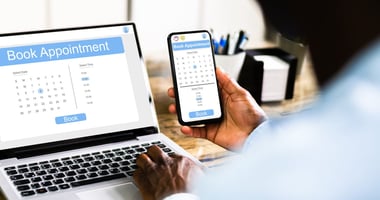5 Strategies to Increase College Enrollment in 2025
Are you frustrated with your admissions yield rate? Do you find it challenging to increase your enrollment and meet your goals? You’re not alone!
At Enrollment Builders, we consult with admissions leaders across the US who frequently ask how to increase enrollment at their university or college. During these conversations, leaders often focus on new marketing strategies, tactics, and campaigns to drive interest and add more leads to the admissions funnel.
Unfortunately, solely focusing on marketing strategies can leave your admissions counselors feeling powerless to make a difference in the numbers that ultimately determine their success. While it’s true that adding more leads to the top of your funnel and collaborating with marketing is essential, it’s not the only option. Your higher ed admissions team can implement strategies on their own to boost conversion rates!
In this article, you’ll learn the five admissions strategies we recommend to higher education institutions that need to increase student enrollment:
- Send automated emails to provide a next step to all new inquiries
- Optimize your admissions outreach methods to meet industry standards
- Build contact cadences to increase conversion rates throughout your admissions funnel
- Implement a strategy to decrease admissions appointment no-shows
- Develop an aged lead re-engagement strategy to maximize your current list
You’ll also find tips for prioritizing which strategies you should implement based on your current admissions funnel metrics and your team’s bandwidth.
After reading, you’ll be better equipped to empower your admissions team with new strategies to boost enrollment at your institution.
1. Send Automated Emails to Provide a Next Step to All New Inquiries
When prospective students fill out an inquiry form on your website, sending an automated confirmation email is standard practice. This can be the starting point of a conversation with an interested individual - especially if they filled out a Request for Information (RFI) form to learn more before applying to your institution.
Unfortunately, some institutions skip this crucial opportunity to engage with new prospective students. Or the confirmation email they send simply states “Thanks for applying, someone will reach out in the next few hours with more information.”
This email is likely the first time the student is hearing from your institution directly, and it sets the tone for the entire admissions experience. Because of this, the email needs to be helpful, actionable, and human.
A typical automated email to new student inquiries should include:
- A clear subject line with your institution’s name
- An individual sender, ideally the admissions counselor that will reach out
- Confirmation that their request was received, with their name and program of interest included
- Information about the program they expressed interest in
- A visualization of your admissions process and a clear promise of what happens next
- Something they can take action on immediately to continue exploring/learning from you
- A link to schedule a call with an admissions counselor
If you already have automated emails established as part of your admissions process, be sure they are reviewed and optimized regularly.
When reviewing your admissions emails, look at the performance of key metrics such as:
- Open Rate: The percentage of received emails that were opened.
- Click Rate: The percentage of opened emails that were clicked.
- Reply Rate: The percentage of opened emails that received a response.
In most cases, you should prioritize improving your emails if your RFI automated email open rate is less than 55%, your click rate is less than 40% and your reply rate is less than 15%.
2. Optimize Your Admissions Outreach Methods to Meet Industry Standards
A common trait among admissions processes is a singular focus on emailing prospective students. However, your students have changed over the years, and so have their preferred communication methods.
Unfortunately, many admissions teams don’t have a consistent way of contacting and nurturing new inquiries. This leaves enrollment leaders wondering whether their outreach efforts match their competitor’s.
Because of this, the first thing we recommend to higher education admissions teams looking to increase student enrollment is to audit their outreach to new inquiries.
Completing an audit will give you a baseline of how consistent your outreach is and whether it meets industry standards for phone calls, texts, and emails.
The benchmarks you should use to measure your admissions outreach methods are:
| Measurement | Industry Benchmark |
| How quickly did your team attempt to call the lead? | <10 minutes |
| How quickly did your team engage the lead by text? | <10 minutes |
| How many calls were made in the first 14 days? | 3 |
| How many texts were sent in the first 14 days? | 6 |
| How many emails were sent in the first 14 days? | 3 |
As you review your admissions team’s outreach according to these benchmarks, consider these questions:
- Are you missing any of the communication methods?
- Is your speed-to-lead within the recommended length of time?
- Is there high variance in the methods or volume of contact attempts depending on the program or admissions counselor?
Your answers to these questions can help you prioritize which areas you should optimize to more effectively turn new inquiries into qualified applicants.
Not sure whether your team’s performance aligns with the industry standards or how to review their outreach? Click here to request your Free Admissions Outreach Audit Report!
3. Build Contact Cadences to Increase Conversion Rates Throughout Your Admissions Funnel
At Enrollment Builders, we use proven contact cadence strategies through a combination of mediums to qualify prospective students for admissions teams so they can focus on having more valuable conversations with interested students.
A contact cadence is the systematic sequence of engagements or follow-ups used by an admissions representative or team to engage with prospective students.
This goes beyond just the first email or text message the prospective student receives. Implementing a full contact cadence strategy is a more robust way to help your admissions counselors build relationships and increase inquiry to application rates.
The most common types of contact cadences within a college admissions strategy are:
- Attempting Cadences establish contact with prospective students so they can be qualified. This allows the institution to start developing a relationship with prospects, inquiries, and stealth applicants.
- Follow-up Cadences nudge prospective students to apply, complete their FAFSA, collect official transcripts, attend orientation, schedule classes, and more.
- Transition Cadences move the student along the admissions funnel as their relationship with the team matures. During this time, they will meet with various subject matter experts, such as the financial aid team, recruiters, advisors, student success, and faculty.
While all of these cadences are beneficial, the most successful admissions teams maximize their time and resources by first implementing an Attempting Cadence for all new inquiries being generated.
That’s because the majority of prospective students are lost on day one if contact isn’t initiated quickly enough. If your team is slower to respond than other institutions the student is considering, you’ve likely lost the chance to earn their enrollment.
Once you have an established attempting cadence, create additional cadences for each stage in the process.
To learn how to plan and implement an admissions contact cadence, read the full article: How to Increase Admissions Conversion Rates with Proven Contact Cadence Strategies
4. Implement a Strategy to Decrease Admissions Appointment No-Shows
One of the biggest frustrations we hear from admissions counselors is when a seemingly interested student doesn’t show up for an appointment.
Surprisingly, on average, 26% of prospective students do not answer the call when the appointment time rolls around. That means 26% of your potential enrollments could be slipping through the cracks at this crucial part of your admissions process!

When your admissions counselor attempts to confirm an appointment, they are fighting for the attention of a prospective student who is inundated by distractions from school, work, friends, and competing institutions.
The key to increasing your enrollment is equipping your admissions counselors to reach distracted prospects and stand out from competing schools. This is why we recommend every admissions team implements an outreach strategy focused on confirming scheduled appointments and following up with no-shows.
At Enrollment Builders, we tailor and execute communication strategies to improve appointment attendance, and on average our clients decrease their appointment no-show rate from 26% to 10%!
To learn more about how you can implement this strategy and see example messaging, read the full article: Cut Admissions Meeting No-Show Rates by 50% with This Strategy
5. Develop an Aged Lead Re-Engagement Strategy to Maximize Your Current List
In our experience of working with colleges and universities, we’ve found one of the best ways to maximize opportunity and increase student enrollment is to re-engage your recently aged leads.
Aged leads are the prospective students in your admissions funnel who have exhausted all of your outreach attempts previously and have been unresponsive for more than 90 days. If your team only reliably attempts to contact leads for 30-60 days after a lead is generated, this window may be much shorter.
In many cases, these aged leads aren’t lost - they just may not have been ready when you were. This is especially true for adult and nontraditional learners. Life happens, and a prospective student’s initial plans or timelines may have changed. Your inquiries deserve to have a method to stay connected to you whether they plan to attend this fall or in three years.

If you have thousands of aged leads and don’t know how to prioritize them, implementing aged lead scoring can help you segment and re-engage the most valuable ones. This admissions strategy will allow you to retroactively work your entire list of aged leads in the next 30 days. Plus, it will help you create a system or routine for reworking aged leads on an ongoing basis so you don’t find yourself in this position again.
Once the aged student leads are prioritized, connect with them in a way that provides ample opportunities for them to respond.
In our experience, using an outreach method similar to an attempting contact cadence can be an effective way for a college or university to re-engage these prospective students.
For more detail on how to implement lead scoring and build your aged lead strategy, read the full article: How to Increase Student Enrollment by Working Aged Leads
How Do You Prioritize Which Admissions Strategy to Implement First?
Now that you’ve read the most common recommendations to help admissions teams boost enrollment, you’re probably wondering: With limited bandwidth to add a lot of new things to the mix, which strategy should we focus on first?
To answer this critical question, you need to understand the current state of your admissions funnel. Seeing the “snapshot” of your current state can help you prioritize which strategies to implement or change to have the biggest impact on increasing enrollment at your institution.
Download our Higher Ed Admissions Funnel Guide to compare your enrollment funnel metrics against the standard benchmarks for higher ed institutions and identify your biggest opportunities for improvement:
If you'd prefer to have a conversation and hear direct recommendations, click here to schedule a short chat with me, Jen Goode, CEO of Enrollment Builders!




